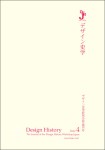目次
巻頭
デザイン史学研究会について
編集方針について
編集委員会と編集諮問委員会
論文
東洋と西洋の融合??ウェルズ・コーツ、ジャポニスムそしてイギリスの近代運動/アナ・バッシャム
岩村透の「ウイリアム、モリスと趣味的社會主義」を再読する/中山修一
特別寄稿
日本におけるデザインのミュージアム??現状と未来/井口壽乃
日本のデザイン・ミュージアム/木村一男
日本の公立美術館におけるデザイン展について/橋本啓子
ハンガラム・デザイン・ミュージアムと韓国におけるデザイン展示の文化/キム・サンキュ
書評
M・アナ・ファリエロ、パウラ・オーウェン編著『オブジェクトと意味??美術と工芸への新たな視点』/ 評者 菊池裕子
後藤武、佐々木正人、深澤直人『デザインの生態学』/評者 小高直樹
菅靖子『イギリスの社会とデザイン??モリスとモダニズムの政治学』/評者 利光功
ノイズ
美術館におけるデザイン鑑賞教育の「今」/橋本優子
投稿要項
会則
執筆者について
–
バックナンバーの購入方法について
巻頭
デザイン史学研究会について
編集方針について
編集委員会と編集諮問委員会
論文1
東洋と西洋の融合——ウェルズ・コーツ、ジャポニスムそしてイギリスの近代運動
アナ・バッシャム
森純子 訳
キーワード
ウェルズ・コーツ、建築、日本、イギリス、ジャポニスム、モダニズム
概要
1850年代中頃から、アール・ヌーヴォーの発展までにおけるイギリスのデザインへの日本からの影響はよく知られているが、両大戦間期の日本からのインスピレーションは、さほど一般には認められていない。しかし、建築家であり、デザイナーでもあったウェルズ・コーツのデザインが実証するように、日本からの影響は、1920年代そして30年代にもみられ、モダニズムのデザインや建築への重要なインスピレーション源であったと考えられる。
イギリスの近代運動の中心人物であったコーツは、彼が日本で受けた教育と幼少期に受けた影響が彼の作品に多大な効果を与えていることにしばしば言及していた。本論文では、コーツのデザインと執筆、日本の建築物に関する記述やイギリスにおけるデザインのモダニズムへの彼の貢献を考察することにより、日本そして日本建築に関する知識の伝道者としてのコーツの重要性を論証することを目的としている。
カナダ建築センターのウェルズ・コーツ資料室での研究から、日本で過ごした成長期に、コーツが日本文化に晒され、それを吸収していったことを確証するに至った。それらの資料がどのように、コーツの作品への私の解釈また理解に通じたかを、本研究にて実証する。
論文2
岩村透の「ウイリアム、モリスと趣味的社會主義」を再読する
中山修一
キーワード
ウィリアム・モリス、社会主義、岩村透、「ウイリアム、モリスと趣味的社會主義」、富本憲吉、「ウイリアム・モリスの話」
概要
日本におけるウィリアム・モリスの紹介は、1890年代のはじめから始まる。それは、極めて断片的なものであり、主として詩人あるいは社会主義者としてのモリスを扱うものであった。その後、英国留学から帰国した、のちに陶芸家となる富本憲吉が、1912年に、エイマ・ヴァランスの書物に基づき、工芸家としてのモリスに関しての評伝を発表し、続いて1915年には、第4次外遊ののち、東京美術学校(現在の東京芸術大学)の西洋美術史の教授であった岩村透が、「ウイリアム、モリスと趣味的社會主義」を書いている。
この論文の目的は、岩村透の「ウイリアム、モリスと趣味的社會主義」に焦点をあて、その内容を検討するとともに、東京美術学校における岩村のかつての学生で、その3年前に「ウイリアム・モリスの話」を執筆していた富本憲吉とのモリスをめぐる関係を明らかにすることにある。
考察の結果、富本が美術学校の学生であったころに、「富本が岩村からモリスについての知識と興味とを植えつけられた」という従来の通説には、必ずしも根拠があるわけではないことが明らかになった。このことは、富本のモリスへの関心が学生時代いかにして形成されたのかについて今後再検証する必要性を意味している。さらに本論文における考察をとおして、岩村が「ウイリアム、モリスと趣味的社會主義」で描き出したモリス像は、底本のアーサー・コムトン=リキットの著作内容からも一部逸脱し、また、社会主義者モリスの実像からも大きく遊離したものであったことも判明した。そうしたモリス像のより適切な修正は、1920年代はじめの、つまり「大正デモクラシー」の絶頂期の新たなモリス研究の再開まで待たなければならなかった。
特別寄稿
日本におけるデザインのミュージアム??現状と未来/井口壽乃
日本のデザイン・ミュージアム/木村一男
日本の公立美術館におけるデザイン展について/橋本啓子
ハンガラム・デザイン・ミュージアムと韓国におけるデザイン展示の文化/キム・サンキュ
書評
M・アナ・ファリエロ、パウラ・オーウェン編著『オブジェクトと意味??美術と工芸への新たな視点』/ 評者 菊池裕子
後藤武、佐々木正人、深澤直人『デザインの生態学』/評者 小高直樹
菅靖子『イギリスの社会とデザイン??モリスとモダニズムの政治学』/評者 利光功
ノイズ
美術館におけるデザイン鑑賞教育の「今」/橋本優子
投稿要項
会則
執筆者について
Contents
Editorial
About the DHWJ
Editorial Policy
Editorial Board and Editorial Advisory Board
Articles
Dovetailing East and West: Wells Coates, Japonisme and the British Modern Movement / Anna Basham
Rereading ‘William Morris and Æsthetic Socialism’ by Iwamura Toru / Nakayama Shuichi
Special Contributions
Design Museums in Japan: Present and Future / Iguchi Toshino
Design Museums in Japan / Kimura Kazuo
The Design Exhibition in Japanese Public Museums / Hashimoto Keiko
Hangaram Design Museum and Design Exhibition Culture in Korea / Kim Sang-kyu
Book Reviews
M. Anna Fariello and Paula Owen eds., Objects and Meaning: New Perspectives on Art and Craft / reviewed by Kikuchi Yuko
Goto Takeshi, Sasaki Masato and Fukazawa Naoto, The Ecological Approach to Design / reviewed by Odaka Naoki
Suga Yasuko, British Society and Design: The Politics of Representing Morris and Modernism / reviewed by Toshimitsu Isao
Noise
Museums in This Country Have Recently Become Too Focused on Education / Hashimoto Yuko
Guidelines for Submission of Manuscripts
Constitution and Bylaws
Notes on Contributors
–
How to Order Your Back Issues
Editorial
About the DHWJ
Editorial Policy
Editorial Board and Editorial Advisory Board
Article 1
Dovetailing East and West: Wells Coates, Japonisme and the British Modern Movement
Anna Basham
Keywords
Wells Coates, Architecture, Japan, Britain, Japonisme, Modernism
Abstract
Japanese ‘influence’ on British design from the mid-1850s until the development of Art Nouveau is generally accepted but during the inter-war period inspiration from Japan is less readily acknowledged. However, this experience continued during the 1920s and 1930s and can be perceived as an important inspiration on Modernist design and architecture, as the work of architect-designer, Wells Coates, demonstrates.
Coates, an eminent member of the British Modem Movement, often referred to his formative upbringing in Japan and it is palpable that this childhood influence had a profound effect upon his work. By an analysis of the designs and writings of Coates, his reference to traditional Japanese architecture and his contribution to Modernism in British design, my PhD research aims to demonstrate the significance of Coates as an important disseminator of knowledge relating to Japan and Japanese architecture.
From my study of the Wells Coates Archive at the Canadian Centre for Architecture, I was able to ascertain, for myself, the extent to which Coates was exposed to Japanese culture whilst growing up in Japan. In this paper I shall demonstrate how these findings have informed my understanding and interpretation of Coates’s work.
Article 2
Rereading ‘William Morris and Æsthetic Socialism’ by Iwamura Toru
Nakayama Shuichi
Keywords
William Morris, Socialism, Iwamura Toru, ‘William Morris and Æsthetic Socialism’, Tomimoto Kenkichi, ‘The Story of William Morris’
Abstract
The introduction of William Morris (1834-1896) in Japan started at the beginning of the 1890s. It treated him rather fragmentarily either as poet or socialist. Later in 1912, Tomimoto Kenkichi (1886-1963) the potter-to-be who had studied Morris’s work and philosophy in London, published a biographical essay on Morris as craftsman, ‘The Story of William Morris’, based on Aymer Vallance’s account. Then Iwamura Toru (1870-1917), Professor in the History of Western Art at Tokyo School of Art (now Tokyo National University of Fine Arts and Music), enjoyed travels in England before publishing an article, entitled ‘William Morris and Æsthetic Socialism’ in 1915.
The purpose of this paper is to explore Iwamura’s article on Morris and is also to clarify the relationship to Morris between Iwamura and Tomimoto at Tokyo School of Art.
In summary, the first section of my paper shows that there is no evidence for the claimed assumption that Iwamura officially through his lectures taught Morris’s work and philosophy to Tomimoto who was a student at the School. This makes it necessary to reexamine how Tomimoto acquired his knowledge of Morris in his student days and why he decided to visit London. Subsequently I clarify that Iwamura not only partly misread Arthur Compton-Rickitt’s William Morris, which he used for his own article, but also in his own way presented another image of Morris as socialist which was extremely far from the real one and was not corrected until new studies on Morris’s socialism were reopened in the beginning of the 1920s, that is to say, in the peak times of so-called Taisho Democracy.
Special Contributions
Design Museums in Japan: Present and Future / Iguchi Toshino
Design Museums in Japan / Kimura Kazuo
The Design Exhibition in Japanese Public Museums / Hashimoto Keiko
Hangaram Design Museum and Design Exhibition Culture in Korea / Kim Sang-kyu
Book Reviews
M. Anna Fariello and Paula Owen eds., Objects and Meaning: New Perspectives on Art and Craft / reviewed by Kikuchi Yuko
Goto Takeshi, Sasaki Masato and Fukazawa Naoto, The Ecological Approach to Design / reviewed by Odaka Naoki
Suga Yasuko, British Society and Design: The Politics of Representing Morris and Modernism / reviewed by Toshimitsu Isao
Noise
Museums in This Country Have Recently Become Too Focused on Education / Hashimoto Yuko
